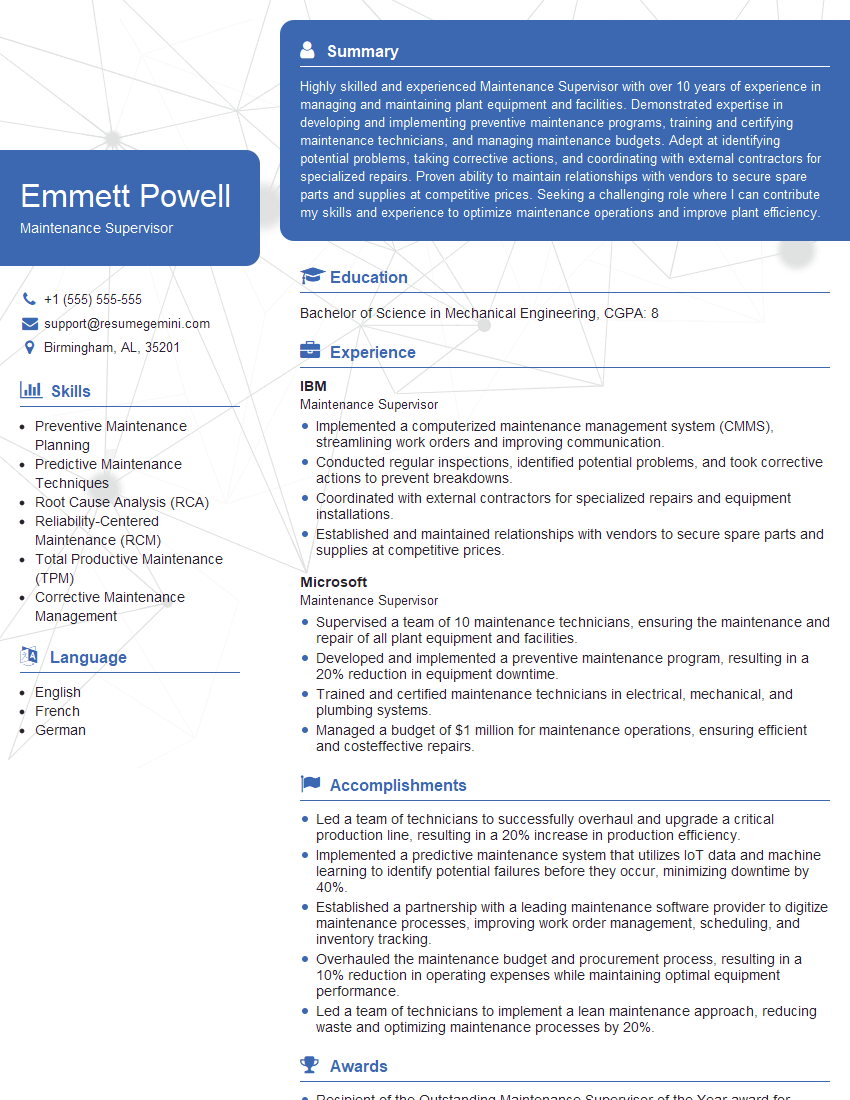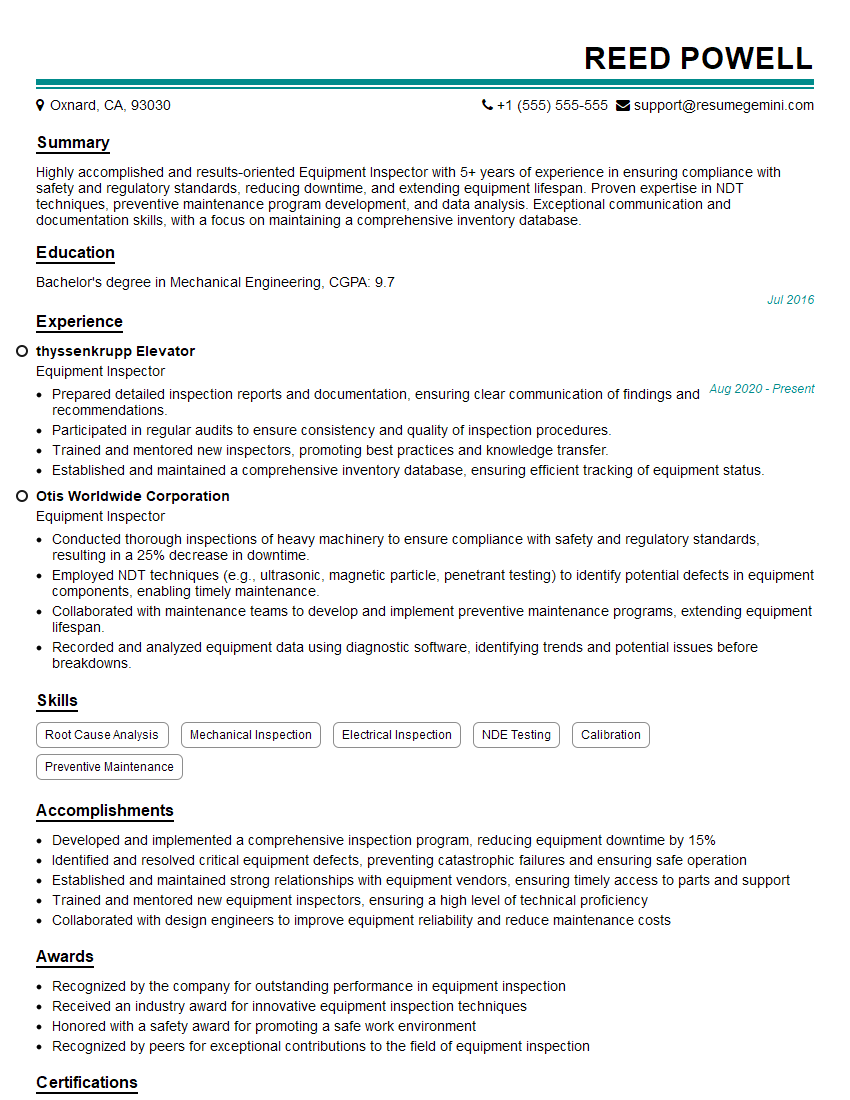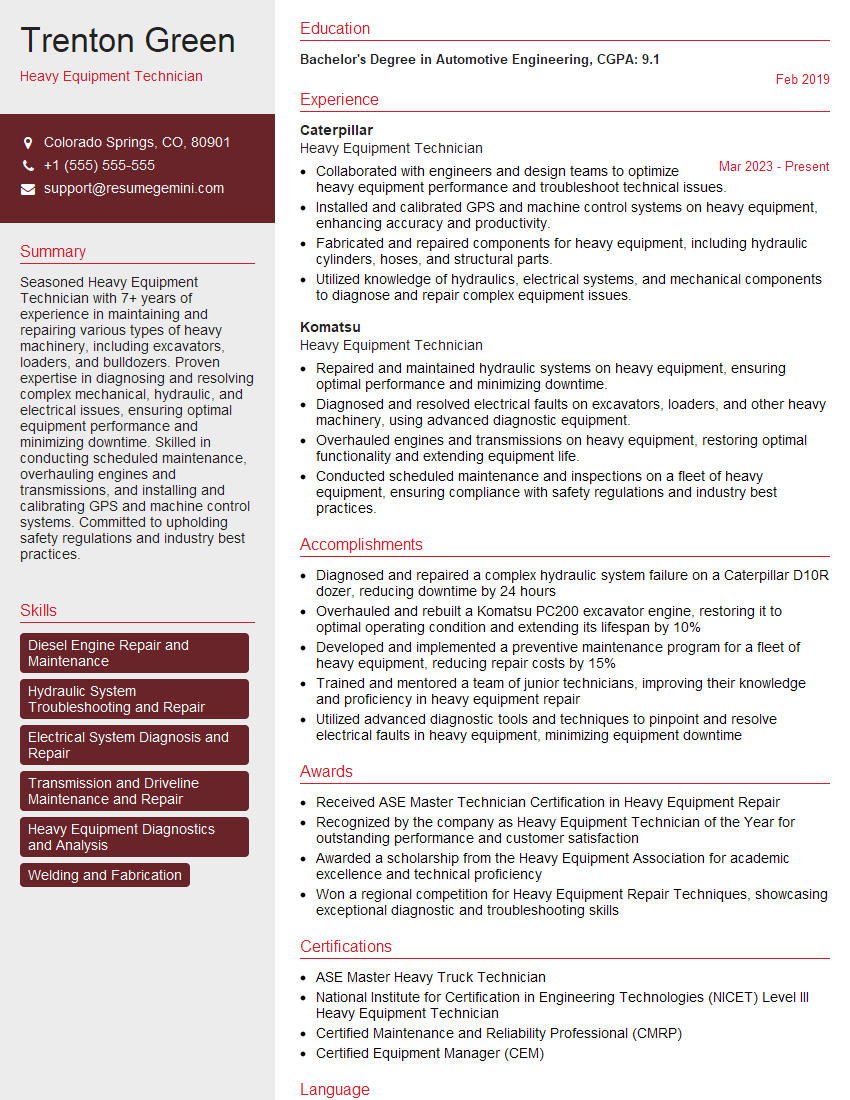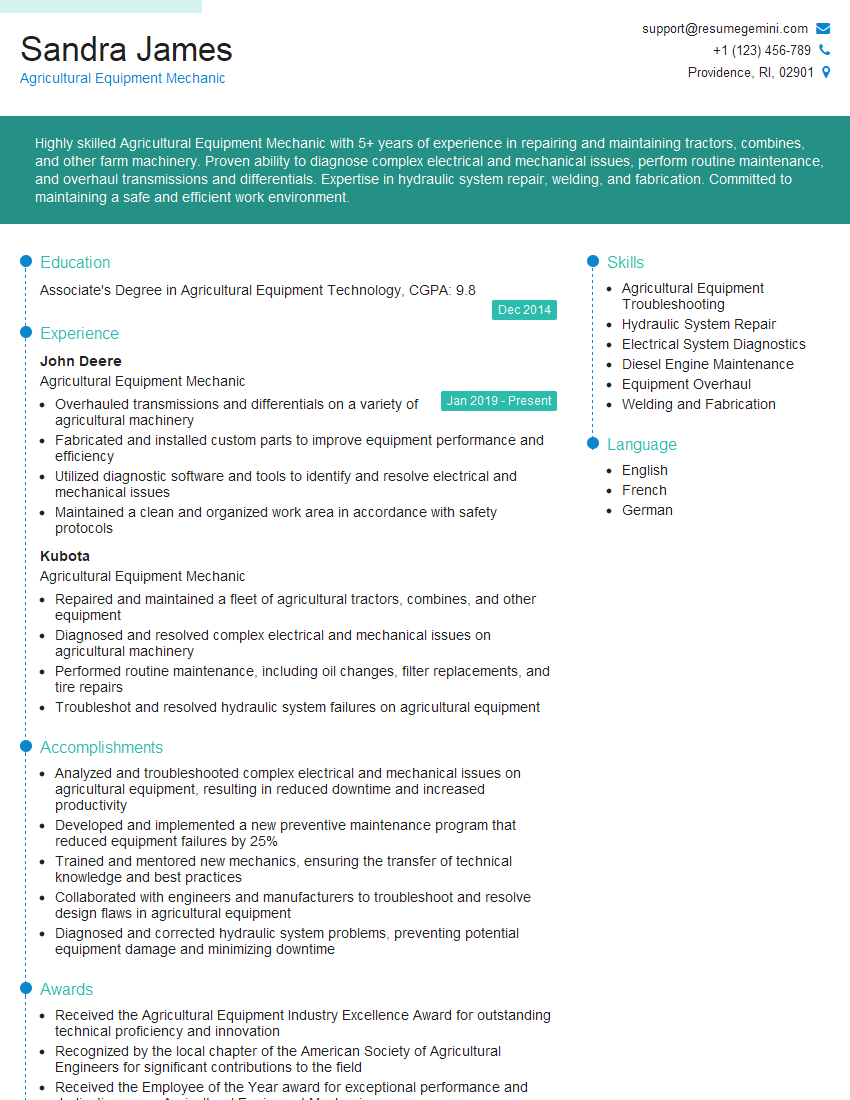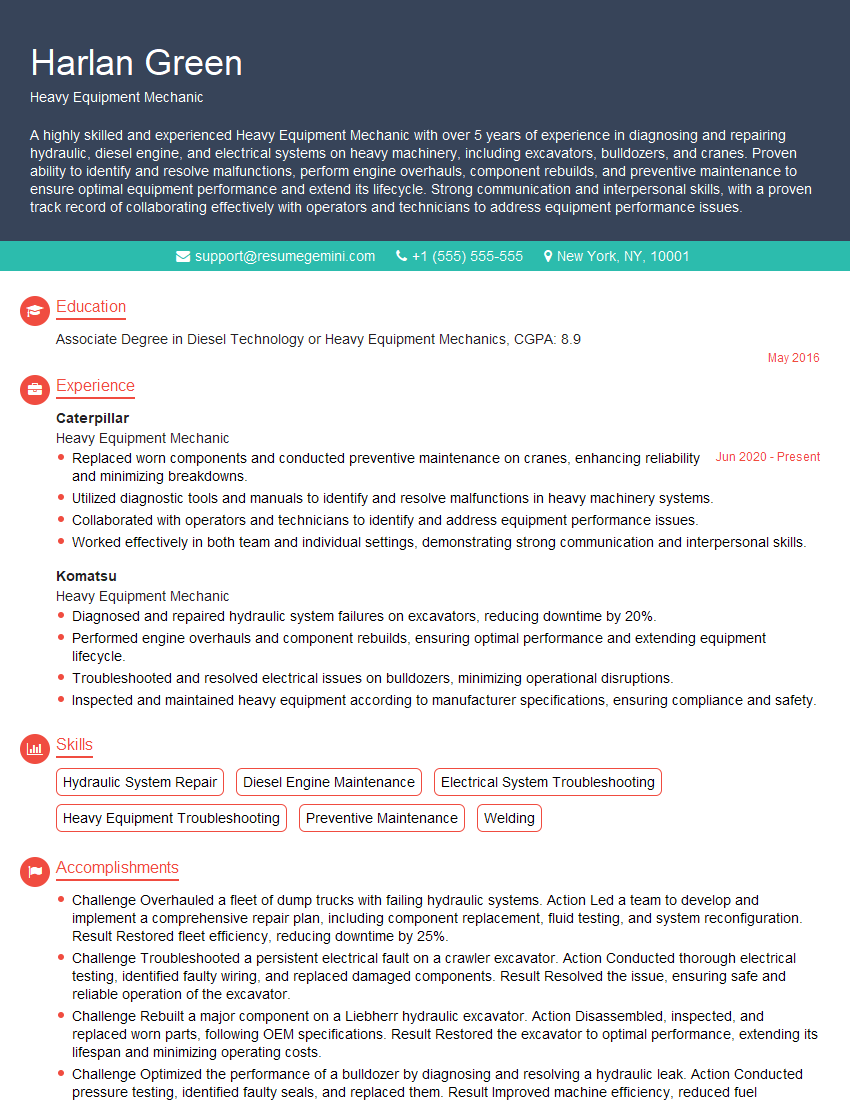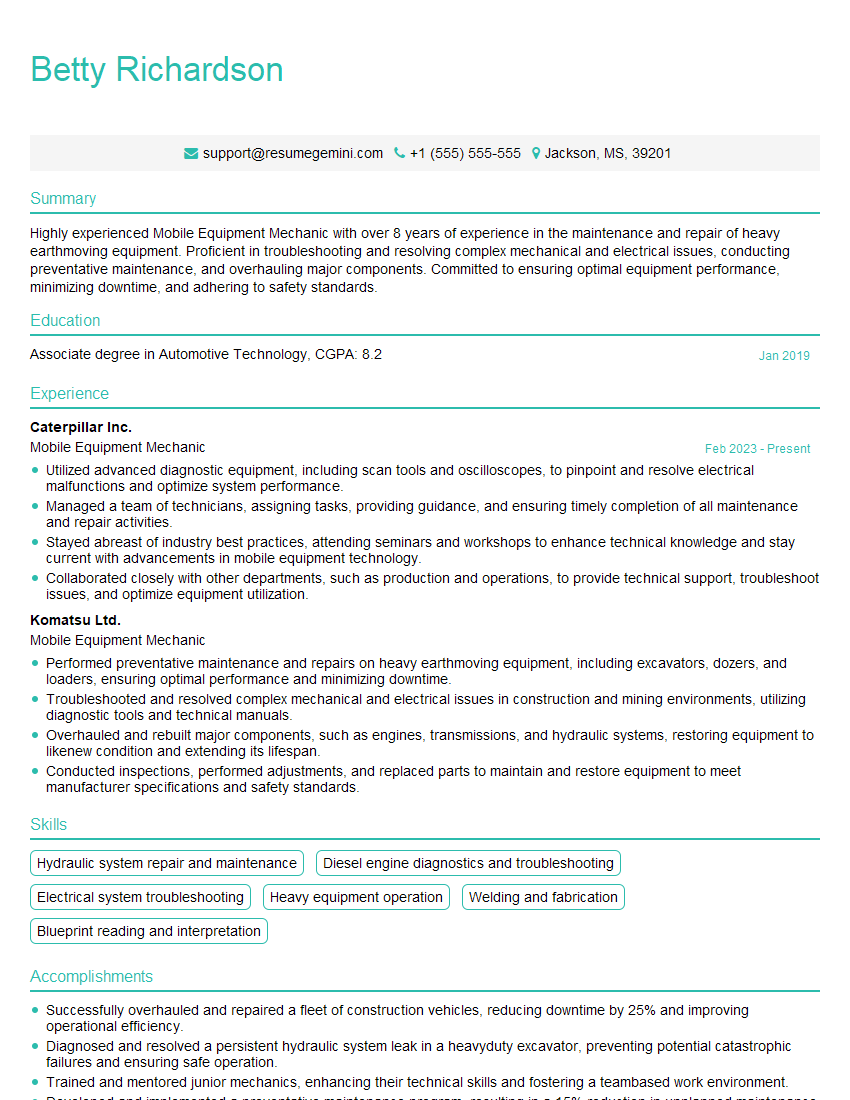Are you ready to stand out in your next interview? Understanding and preparing for Experience in managing and maintaining heavy equipment interview questions is a game-changer. In this blog, we’ve compiled key questions and expert advice to help you showcase your skills with confidence and precision. Let’s get started on your journey to acing the interview.
Questions Asked in Experience in managing and maintaining heavy equipment Interview
Q 1. Describe your experience with preventative maintenance schedules for heavy equipment.
Preventative maintenance schedules are crucial for extending the lifespan and ensuring the reliable operation of heavy equipment. Think of it like regular check-ups for your car – it’s much cheaper and more efficient to prevent problems than to fix them after they occur. My approach involves a multi-faceted strategy incorporating manufacturer recommendations, operational data analysis, and environmental factors.
- Manufacturer’s Recommendations: I meticulously follow the manufacturer’s recommended service intervals and checklists, which often outline specific tasks such as oil changes, filter replacements, and inspections of critical components at specific intervals (e.g., every 500 hours, every year).
- Operational Data Analysis: I track equipment usage, including operational hours, fuel consumption, and performance metrics. This data helps identify trends that might indicate potential issues before they become major problems. For instance, a sudden increase in fuel consumption could signal a problem with the engine’s efficiency, prompting a closer examination.
- Environmental Factors: I consider the operating environment. Equipment operating in harsh conditions (extreme temperatures, dusty environments) requires more frequent maintenance.
For example, on a recent project involving excavators operating in a quarry, I implemented a more rigorous preventative maintenance schedule, including more frequent checks of the undercarriage components due to the abrasive nature of the environment. This proactive approach prevented costly breakdowns and kept the project on schedule.
Q 2. What diagnostic tools are you proficient in using for troubleshooting heavy equipment issues?
Proficient use of diagnostic tools is essential for efficient troubleshooting. My expertise spans a range of technologies, from basic hand-held tools to sophisticated computerized diagnostic systems.
- Hand-held Tools: Multimeters for checking electrical circuits, pressure gauges for hydraulic systems, and compression testers for diesel engines are staples in my toolbox. I’m adept at interpreting the readings from these tools to isolate problems.
- Computerized Diagnostic Systems (OBD-II and manufacturer-specific systems): Many modern heavy equipment machines have onboard diagnostic systems that provide detailed fault codes. I’m proficient in using these systems to pinpoint issues. This allows me to quickly diagnose and rectify problems without unnecessary disassembly.
- Specialized Testing Equipment: Depending on the specific equipment and problem, I use more specialized diagnostic tools such as leak detectors for hydraulic systems, vibration analyzers for detecting bearing issues, and thermal imaging cameras for identifying overheating components.
For instance, using an OBD-II system on a loader, I once quickly identified a faulty sensor causing erratic engine performance, preventing a more extensive and time-consuming investigation.
Q 3. Explain your process for identifying and repairing hydraulic system leaks.
Hydraulic system leaks are serious and require a systematic approach to repair. The process involves careful identification of the source, determining the cause, and finally, effecting the repair.
- Identify the Leak: This often involves visual inspection, sometimes enhanced with dye tracing or pressure testing. The goal is to pinpoint the precise location of the leak.
- Determine the Cause: Once the location is found, I determine the cause—a faulty hose, damaged seal, cracked component, or loose fitting. This step often requires careful observation and sometimes the use of specialized tools like pressure gauges to understand the system’s pressure and flow characteristics.
- Repair the Leak: Repairs vary depending on the cause. It might involve replacing a hose, seal, or component. This often necessitates using specialized tools and adhering strictly to safety procedures.
- System Testing: After the repair, I conduct thorough testing to confirm that the leak is fixed and the hydraulic system is functioning correctly.
For example, I once identified a leak in a hydraulic cylinder on a bulldozer by using a dye to trace the leak. It turned out to be a damaged seal which was quickly replaced, preventing further damage and downtime.
Q 4. How do you handle emergency repairs on heavy equipment in the field?
Emergency repairs in the field demand quick thinking, resourcefulness, and a strong understanding of both the equipment and safety protocols. My approach is guided by the principles of minimizing downtime and ensuring safety.
- Assessment: Quickly assess the situation, determining the nature of the problem and the potential safety risks.
- Emergency Repair: If possible, I implement a temporary fix to get the equipment operational until a more permanent solution can be implemented. This might involve using makeshift repairs or replacing a component with an available spare part.
- Safety First: Prioritize safety above all else. I ensure the area is secured, use appropriate safety equipment, and if the problem is beyond my immediate capabilities, I immediately contact support and arrange for professional assistance.
- Documentation: Once the situation is under control, I thoroughly document the event, including the nature of the problem, the temporary fix (if any), and the steps taken. This is critical for reporting and for planning future preventative maintenance.
In one instance, a critical hydraulic line broke on an excavator in a remote location. I managed to use a temporary clamp and reinforced hose to temporarily restore function, allowing the work to continue while we arranged for a replacement line to be delivered. Safety was paramount, so the area was secured, and warning signs were posted until the repair was complete.
Q 5. What safety protocols do you follow when working on heavy equipment?
Safety is paramount in all aspects of heavy equipment maintenance. My safety protocols adhere to all relevant industry standards and best practices.
- Lockout/Tagout (LOTO): Before performing any maintenance, I always use LOTO procedures to isolate the energy sources, ensuring that the equipment cannot unexpectedly start. This prevents serious injury.
- Personal Protective Equipment (PPE): I always use appropriate PPE, including safety glasses, gloves, hearing protection, and steel-toed boots, depending on the task.
- Safe Work Practices: I follow established safe work procedures when lifting heavy components, using tools, and working at heights or in confined spaces.
- Awareness of Surroundings: I am always aware of my surroundings, paying attention to potential hazards like overhead power lines, moving vehicles, and other equipment.
- Regular Inspections: I routinely inspect tools and equipment for damage or defects before use, and immediately replace any unsafe items.
These procedures are not just rules; they are ingrained habits. It’s better to take a few extra minutes to ensure safety than to experience the potentially devastating consequences of a workplace accident.
Q 6. Describe your experience with diesel engine repair and maintenance.
Diesel engine repair and maintenance is a significant part of my experience. My knowledge spans everything from preventative maintenance to complex overhauls.
- Preventative Maintenance: This includes regular oil changes, filter replacements, fuel system checks, and inspections of critical components such as belts, hoses, and injectors. I use manufacturer’s recommendations and operational data to tailor preventative maintenance schedules for optimum performance and reliability.
- Troubleshooting and Repair: I am experienced in diagnosing and repairing a wide range of diesel engine problems. This includes identifying issues related to fuel injection, lubrication, cooling, and electrical systems. Diagnostic tools such as compression testers, fuel pressure gauges, and engine analyzers play a crucial role in these processes.
- Overhauls: I have experience in performing major engine overhauls, including replacing pistons, rings, bearings, and other worn components. This requires a deep understanding of diesel engine operation, precision, and adherence to strict procedures.
For example, I recently diagnosed a low compression issue in a diesel engine by using a compression tester. I then identified a faulty piston ring, which was replaced, restoring the engine’s performance to factory specifications.
Q 7. How do you prioritize repair tasks when faced with multiple equipment malfunctions?
Prioritizing repair tasks when faced with multiple equipment malfunctions requires a systematic approach. My process involves a risk-based assessment and prioritization framework.
- Safety First: Any issues posing an immediate safety risk (e.g., a major hydraulic leak, a significant electrical fault) are addressed immediately. Safety always comes first.
- Impact Assessment: I assess the impact of each malfunction on operations. Malfunctions affecting critical tasks or causing significant downtime are prioritized higher.
- Urgency and Severity: I consider the urgency and severity of each problem. An urgent problem that needs immediate attention will take precedence over a less urgent issue, even if the latter might have a higher overall impact.
- Resource Availability: I also consider the resources needed for each repair, such as parts availability, specialized tools, and personnel. Repairs requiring readily available resources are given priority.
- Documentation and Planning: I document all malfunctions, their priority levels, and planned repair times. This allows for efficient task management and helps prevent overlooking any issue.
This process helps ensure that limited resources are effectively allocated, maximizing efficiency and minimizing overall downtime.
Q 8. What is your experience with different types of heavy equipment (e.g., excavators, loaders, bulldozers)?
My experience with heavy equipment spans over 15 years, encompassing a wide range of machinery. I’m proficient in operating, maintaining, and troubleshooting various types, including excavators (both hydraulic and cable-operated), wheel loaders, bulldozers (tracked and wheeled), backhoes, and articulated dump trucks. My experience isn’t limited to just one manufacturer; I’ve worked with machines from Caterpillar, Komatsu, John Deere, and Volvo, giving me a broad understanding of different design philosophies and mechanical systems.
For example, I’ve extensively used hydraulic excavators for trenching, excavation, and demolition projects, mastering various attachment configurations like breakers, grapples, and rippers. With wheel loaders, my focus has been on material handling in construction sites and quarries, optimizing loading and transport cycles. My experience with bulldozers centers on earthmoving operations, including land clearing, grading, and road construction, where understanding blade control and ground conditions is paramount.
Q 9. How do you maintain accurate records of equipment maintenance and repairs?
Maintaining accurate equipment records is crucial for preventative maintenance and minimizing downtime. I use a combination of digital and physical methods. For every piece of equipment, I keep a dedicated file, both physical and digital. This file includes the equipment’s operating manual, a detailed maintenance log, repair records, and parts inventory. The maintenance log meticulously documents all scheduled maintenance activities (e.g., oil changes, filter replacements, lubrication), noting the date, service performed, and the technician’s initials. Repair records detail any unexpected repairs, including the nature of the problem, the parts used, labor hours, and the cost. I also utilize a CMMS (Computerized Maintenance Management System), discussed later, to streamline this process, generate reports, and track equipment performance.
Q 10. Explain your understanding of OSHA regulations related to heavy equipment maintenance.
My understanding of OSHA regulations regarding heavy equipment maintenance is comprehensive. I am familiar with standards such as 29 CFR 1926, which covers construction and demolition, and specifically addresses requirements for equipment safety, preventative maintenance programs, and operator training. This includes regulations on lockout/tagout procedures for servicing equipment, ensuring proper guarding of moving parts, and the use of personal protective equipment (PPE) like safety glasses, gloves, and hearing protection during maintenance. I also understand the regulations around safe working conditions, including proper lighting, signage, and the use of barriers to prevent unauthorized access. Compliance with these regulations is paramount in preventing workplace accidents and injuries, ensuring a safe work environment.
Q 11. Describe a time you had to troubleshoot a complex mechanical issue on heavy equipment.
During a road construction project, a bulldozer experienced a sudden loss of power and a strange knocking sound. Initially, I suspected an issue with the transmission. However, after a thorough visual inspection and listening to the engine, I discovered the problem stemmed from a broken connecting rod in the engine itself.
My troubleshooting process involved several steps: First, a systematic check of the engine’s vital signs – oil pressure, coolant temperature, and fuel supply. Then, I carefully listened to the engine to pinpoint the source of the knocking sound. Finally, removing the engine’s side panels revealed the broken connecting rod. The repair involved sourcing the replacement part, carefully disassembling the engine, replacing the faulty rod, reassembling the engine, and thoroughly testing all systems before returning the bulldozer to service. This experience highlighted the importance of careful listening, methodical troubleshooting, and a thorough understanding of internal combustion engine mechanics.
Q 12. How do you ensure the safe operation of heavy equipment after maintenance or repairs?
Ensuring the safe operation of heavy equipment after maintenance or repair is a critical responsibility. Before any equipment is returned to service, a comprehensive pre-operational inspection is mandatory. This inspection covers all systems, including hydraulics, electrical components, brakes, and steering mechanisms. A test run is then conducted, under controlled conditions, to verify the correct functionality of all systems. The operator receives a thorough briefing on the repairs carried out and any potential points to note during operation. Detailed documentation of the inspection and test run is recorded in the equipment’s maintenance log. Ultimately, confirming the equipment is safe is paramount to worker and public safety.
Q 13. What is your experience with different types of heavy equipment transmissions?
My experience with heavy equipment transmissions encompasses various types, including manual, automatic (torque converter), and powershift transmissions. I understand the operation and maintenance of these different types and their unique characteristics. Manual transmissions require regular clutch adjustments and gear shifting precision; automatic transmissions require attention to fluid levels and filter maintenance; while powershift transmissions require specialized diagnostics to address problems with shifting solenoids and hydraulic pressures. Diagnosing problems within these systems requires a deep understanding of hydraulic systems, pressure readings, and gear ratios. My experience includes working on both hydrostatic and planetary gear systems found in various heavy machinery.
Q 14. How familiar are you with computerized maintenance management systems (CMMS)?
I am highly familiar with computerized maintenance management systems (CMMS). I have extensive experience using CMMS software to schedule preventative maintenance, track repair costs, manage inventory, and generate reports on equipment utilization and performance. This experience includes data entry, report generation, and analysis to improve maintenance strategies. A CMMS effectively streamlines maintenance procedures, improves efficiency, and contributes greatly to cost savings by minimizing unexpected breakdowns and optimizing maintenance schedules. Specific CMMS platforms I’ve utilized include IBM Maximo and Fiix – though my skills are transferable to other systems.
Q 15. Describe your experience with welding and fabrication techniques relevant to heavy equipment repair.
My welding and fabrication experience is extensive, honed over years of working on heavy equipment. I’m proficient in various welding processes, including MIG, TIG, and stick welding, selecting the appropriate method based on the material and the repair needed. For example, I’ve used TIG welding for precision repairs on delicate hydraulic lines, ensuring a leak-free, structurally sound joint. MIG welding is my go-to for heavier repairs on things like excavator buckets or loader arms, where speed and strength are paramount. Stick welding is useful in challenging outdoor environments where access to power is limited.
Fabrication involves more than just welding; it requires understanding material properties and structural integrity. I’ve fabricated custom brackets, mounts, and even entire sections of damaged equipment using steel, aluminum, and various other metals. A recent example involved creating a custom support bracket for a damaged grader blade using high-strength steel. Careful measurements, precise cutting, and robust welding ensured the repair was both strong and long-lasting. My experience extends to understanding blueprints, creating fabrication drawings, and working with various hand tools and machinery for cutting, shaping, and finishing the fabricated components.
Career Expert Tips:
- Ace those interviews! Prepare effectively by reviewing the Top 50 Most Common Interview Questions on ResumeGemini.
- Navigate your job search with confidence! Explore a wide range of Career Tips on ResumeGemini. Learn about common challenges and recommendations to overcome them.
- Craft the perfect resume! Master the Art of Resume Writing with ResumeGemini’s guide. Showcase your unique qualifications and achievements effectively.
- Don’t miss out on holiday savings! Build your dream resume with ResumeGemini’s ATS optimized templates.
Q 16. How do you interpret and understand technical manuals and schematics for heavy equipment?
Interpreting technical manuals and schematics is fundamental to my work. I approach them systematically. First, I’ll familiarize myself with the overall system’s layout – understanding the various components and their interconnections. Then, I’ll meticulously follow the diagrams, cross-referencing them with textual descriptions. I pay close attention to details, like part numbers, torque specifications, and wiring diagrams. Think of it like following a detailed recipe – you need to understand each ingredient and the sequence of steps to achieve the desired outcome.
For example, when troubleshooting a complex hydraulic system, I’ll start by consulting the schematic to trace the flow of hydraulic fluid, identify potential pressure drop points, and locate specific valves or components. These manuals are more than just diagrams; they’re troubleshooting guides, offering valuable insights into potential problems and step-by-step solutions. I’m also adept at using Computerized Maintenance Management Systems (CMMS) which integrate seamlessly with the technical manuals and provide valuable data for preventative maintenance scheduling.
Q 17. How do you manage inventory of parts and supplies needed for heavy equipment maintenance?
Efficient inventory management is critical for minimizing downtime. I employ a combination of methods. We use a computerized inventory system to track parts, ensuring we have adequate stock of commonly used items. This system generates alerts when stock levels fall below a pre-determined threshold, allowing for timely ordering. For less common parts, we maintain a detailed catalog with suppliers’ information, enabling quick ordering when needed. Regular inventory audits help identify discrepancies and ensure the system’s accuracy. We also use a ‘Just-in-time’ system for certain high-cost items, ordering them only when a specific repair is scheduled, minimizing storage costs and reducing the risk of obsolescence.
Think of it like a well-stocked kitchen – you need the essential ingredients readily available to prepare daily meals, while specialized items are ordered as needed for special occasions. This ensures that we don’t tie up capital in unnecessary inventory, while still maintaining the ability to handle unexpected repairs promptly.
Q 18. What is your experience with engine diagnostics and using diagnostic software?
Engine diagnostics is a crucial skill. My experience spans various engine types, from diesel to gasoline, and I’m proficient in using diagnostic software specific to different manufacturers. I start by visually inspecting the engine for obvious issues like leaks or loose connections. Then, I’ll use the diagnostic software to retrieve trouble codes (DTCs), analyzing them to pinpoint the likely cause of the problem. This software provides real-time data on engine parameters such as fuel pressure, cylinder compression, and exhaust gas temperature.
For instance, if a DTC indicates a low fuel pressure, I’ll systematically check the fuel system, including the fuel pump, filters, and injectors, using the software’s data to guide my investigation. I also use specialized tools like compression testers and leak detectors. The diagnostic software’s ability to log data over time helps to identify intermittent problems that might not be apparent during a single test.
Q 19. Describe your experience with electrical system repair on heavy equipment.
Electrical system repair on heavy equipment requires a systematic approach. I’m familiar with troubleshooting various electrical components, including alternators, starters, wiring harnesses, sensors, and control modules. I begin by using a multimeter to check voltage and current levels, identifying short circuits, open circuits, and other electrical faults. I’m proficient in reading electrical schematics, tracing wires, and identifying faulty components. I also use specialized tools like current clamps and diagnostic scanners to assist in troubleshooting.
Recently, I repaired a malfunctioning lighting system on a large excavator. By carefully tracing the wiring harness, I identified a broken wire causing the problem. After repairing the wire and testing the circuit, the lighting system was restored. Safety is paramount when working with electrical systems, so I always follow appropriate lockout/tagout procedures to prevent accidental electrocution.
Q 20. How do you ensure compliance with environmental regulations during heavy equipment maintenance?
Environmental compliance is a top priority. We adhere strictly to regulations regarding the handling and disposal of hazardous materials such as used oil, fuel, and antifreeze. This includes using designated containers, proper labeling, and following procedures for recycling or disposal through licensed facilities. We also utilize spill kits for containing and cleaning up accidental spills. Regular training ensures that all personnel are aware of and comply with these regulations. Documentation is meticulously maintained to demonstrate compliance with environmental regulations.
For example, all used oil is collected in designated drums and sent to a licensed recycling facility, and all records of this process are kept for auditing purposes. We also use environmentally friendly cleaning agents whenever possible, minimizing the environmental impact of our maintenance activities.
Q 21. What is your experience with hydraulic component repair and replacement?
Hydraulic systems are complex, and their repair requires specialized knowledge. I have experience diagnosing and repairing various hydraulic components, including pumps, valves, cylinders, and hoses. I’m proficient in using specialized tools like pressure gauges, flow meters, and hydraulic test benches. I understand the importance of clean hydraulic fluid and proper filtration to prevent component damage. Troubleshooting often involves systematically checking for leaks, pressure drops, and flow restrictions.
A recent repair involved a faulty hydraulic cylinder on a bulldozer. After identifying the leak and checking the cylinder’s internal components, I concluded that a seal was the root cause of the malfunction. By replacing the seal, the hydraulic cylinder was restored to full functionality. Safety is critical when dealing with high-pressure hydraulic systems; I always follow established procedures to prevent injuries and ensure safe operation.
Q 22. Describe your experience with troubleshooting and repairing braking systems in heavy equipment.
Troubleshooting and repairing braking systems in heavy equipment requires a systematic approach, combining diagnostic skills with a deep understanding of hydraulics, pneumatics, and mechanical components. I begin by visually inspecting the system for leaks, worn components, or obvious damage. This often involves checking brake lines, calipers, pads, drums, and air pressure systems (depending on the type of braking system).
For example, I once diagnosed a loss of braking power in a large excavator. Initial inspection revealed no visible leaks. However, upon closer examination, I discovered a small crack in a hydraulic line near the brake actuator. Replacing that line immediately restored braking function.
If the visual inspection yields no immediate solution, I’ll then use diagnostic tools such as pressure gauges and leak detectors to pinpoint the problem. For air brake systems, I might check air compressor output, reservoir pressure, and the integrity of the air lines. For hydraulic systems, pressure readings at various points in the circuit can reveal blocked lines, faulty pumps, or problems with the brake actuators. Once the faulty component is identified, I perform the necessary repair, ensuring proper bleeding and testing before returning the equipment to service. Safety is paramount, so I always adhere to strict safety protocols throughout the process.
Q 23. How do you handle situations where equipment malfunctions cause project delays?
Equipment malfunctions leading to project delays are a serious concern, demanding immediate and effective action. My approach is threefold: immediate assessment, rapid repair, and preventative measures. First, I conduct a thorough assessment to determine the extent of the malfunction and its impact on the project timeline. This involves identifying the root cause of the failure, assessing the availability of spare parts, and evaluating potential workarounds.
For instance, a critical hydraulic pump failure on a bulldozer meant we risked missing a crucial deadline. My team and I immediately prioritized obtaining a replacement pump. While waiting, we worked with the project manager to reschedule non-critical tasks and explored if we could partially utilize the equipment (if safe). The replacement pump arrived quickly, allowing for a swift repair.
After repairing the equipment, I analyze the cause of the failure to implement preventative measures. This could involve scheduling more frequent maintenance checks, adopting improved lubrication schedules, or even recommending equipment upgrades. Transparency with the project team and proactive communication regarding the delay and its resolution are crucial to maintaining trust and minimizing disruptions.
Q 24. What are the common causes of engine overheating in heavy equipment, and how do you address them?
Engine overheating in heavy equipment is a significant problem that can lead to costly repairs. The common causes fall into several categories: insufficient coolant, clogged radiator, faulty water pump, malfunctioning thermostat, and problems with the cooling fan.
- Insufficient Coolant: Low coolant levels due to leaks or evaporation can cause the engine to overheat. Regular coolant level checks are vital.
- Clogged Radiator: Debris buildup in the radiator restricts airflow and reduces cooling efficiency. Regular cleaning or replacement is often necessary.
- Faulty Water Pump: A malfunctioning water pump can impede coolant circulation, leading to overheating.
- Malfunctioning Thermostat: A stuck thermostat can prevent coolant from circulating correctly.
- Cooling Fan Problems: A non-functional cooling fan is a major contributor to overheating.
Addressing these issues involves systematically checking each component. For instance, I’ll first check the coolant level, inspect the radiator for clogs, and test the water pump and thermostat using appropriate diagnostic tools. The solution will depend on the identified problem – from simply refilling coolant to replacing a faulty pump or radiator.
Q 25. Describe your experience with tire maintenance and repair on heavy equipment.
Tire maintenance and repair on heavy equipment is crucial for safety and operational efficiency. It involves regular inspections, proper inflation, and timely repairs or replacements. I begin by visually inspecting tires for cuts, bulges, embedded objects, and uneven wear. Proper inflation pressure is critical – underinflation leads to premature wear and increased risk of failure, while overinflation can cause damage to the tire and the rim.
I’ve handled various tire issues, from simple punctures that could be patched using specialized heavy-duty repair kits to more complex situations like sidewall damage requiring replacement. Larger equipment often uses specialized, expensive tires. Knowing when to repair versus replace is essential, balancing cost-effectiveness with safety considerations. We also use tire pressure monitoring systems (TPMS) on many machines to alert us to pressure issues before they become critical, preventing downtime and potential accidents. Safe tire changing procedures involving heavy lifting equipment and proper handling of the tires is also a critical aspect of my work.
Q 26. What is your proficiency in using specialized tools and equipment for heavy equipment repair?
My proficiency in using specialized tools and equipment for heavy equipment repair is extensive. This includes a wide range of tools, from basic hand tools such as wrenches, sockets, and screwdrivers to sophisticated diagnostic equipment like engine analyzers, hydraulic pressure testers, and specialized welding equipment. I’m also familiar with various lifting devices, including cranes and jacks, essential for safe and effective repairs.
For example, I routinely utilize diagnostic software to troubleshoot complex electronic control systems in modern heavy equipment. I’m comfortable using specialized torque wrenches to ensure proper tightening of critical fasteners. I’m also proficient in using welding and cutting equipment for repairs on various components. Understanding the proper use and maintenance of these tools is as crucial as the repair itself, to ensure accuracy, efficiency, and prevent further damage or injury.
Q 27. How do you stay up-to-date with the latest advancements in heavy equipment technology and maintenance practices?
Staying current with advancements in heavy equipment technology and maintenance is a continuous process. I actively participate in professional development activities, such as attending industry conferences, workshops, and training courses offered by equipment manufacturers. This ensures I’m updated on the latest diagnostic tools, repair techniques, and technological upgrades.
I also subscribe to industry publications and online resources, keeping abreast of best practices and emerging technologies. Manufacturer’s service manuals are crucial, providing detailed specifications and troubleshooting guides for specific equipment models. Active participation in online forums and communities focused on heavy equipment maintenance allows me to share knowledge and learn from others’ experiences. This commitment to continuous learning is crucial to ensure I maintain the highest level of competence in this rapidly evolving field.
Q 28. Describe a time you had to train or mentor a junior technician on heavy equipment maintenance procedures.
I recently mentored a junior technician, Alex, on the intricacies of hydraulic system repair in excavators. Alex was technically proficient but lacked practical experience. My approach involved a hands-on, progressive learning strategy. I started by explaining the basic principles of hydraulics using simple analogies, comparing the hydraulic system to the circulatory system of the human body.
We then worked together on a real-world project – diagnosing and repairing a hydraulic leak in an excavator. I guided Alex through each step: inspecting the system, using pressure gauges to isolate the leak, tracing the hydraulic lines, and identifying the faulty component. I emphasized safety protocols throughout the process. This mentoring experience was highly rewarding, not only for Alex’s skill development, but also for reinforcing my own understanding and teaching skills.
Key Topics to Learn for Experience in managing and maintaining heavy equipment Interview
- Equipment Operation & Proficiency: Demonstrate a deep understanding of operating various heavy equipment types (e.g., excavators, bulldozers, loaders) and their specific applications. Be prepared to discuss your experience levels and proficiency with different models and functionalities.
- Preventive Maintenance & Inspection: Detail your experience in performing routine inspections, identifying potential issues, and executing preventative maintenance schedules to maximize equipment lifespan and minimize downtime. Highlight your knowledge of maintenance logs and best practices.
- Troubleshooting & Repair: Explain your approach to diagnosing mechanical and operational problems. Describe your experience in troubleshooting malfunctions, performing minor repairs, and knowing when to call for expert assistance. Include examples of problem-solving using your technical skills.
- Safety Procedures & Regulations: Emphasize your commitment to safety protocols and adherence to industry regulations. Discuss your experience with pre-operational checks, hazard identification, and accident prevention techniques. Highlight any relevant certifications or training.
- Fuel Efficiency & Cost Optimization: Discuss your understanding of fuel consumption and strategies for optimizing equipment performance to reduce operating costs. Be prepared to share examples of how you have implemented cost-saving measures.
- Teamwork & Communication: Explain how you collaborate effectively with other team members, communicate technical issues clearly, and contribute to a safe and productive work environment.
- Data Management & Reporting: Describe your experience with maintaining equipment logs, tracking performance metrics, and generating reports on equipment usage, maintenance, and costs.
Next Steps
Mastering the skills and knowledge related to managing and maintaining heavy equipment is crucial for career advancement in this field. A strong understanding of these areas opens doors to higher-paying roles with increased responsibility and opportunities for professional growth. To maximize your job prospects, it’s essential to create an ATS-friendly resume that effectively showcases your qualifications. ResumeGemini is a trusted resource that can help you build a professional and impactful resume that stands out to recruiters. Examples of resumes tailored to highlight experience in managing and maintaining heavy equipment are available to help you get started.
Explore more articles
Users Rating of Our Blogs
Share Your Experience
We value your feedback! Please rate our content and share your thoughts (optional).
What Readers Say About Our Blog
Hi, I have something for you and recorded a quick Loom video to show the kind of value I can bring to you.
Even if we don’t work together, I’m confident you’ll take away something valuable and learn a few new ideas.
Here’s the link: https://bit.ly/loom-video-daniel
Would love your thoughts after watching!
– Daniel
This was kind of a unique content I found around the specialized skills. Very helpful questions and good detailed answers.
Very Helpful blog, thank you Interviewgemini team.
